The Cambridge History of Japan, Vol. 1: Ancient Japan
Подождите немного. Документ загружается.

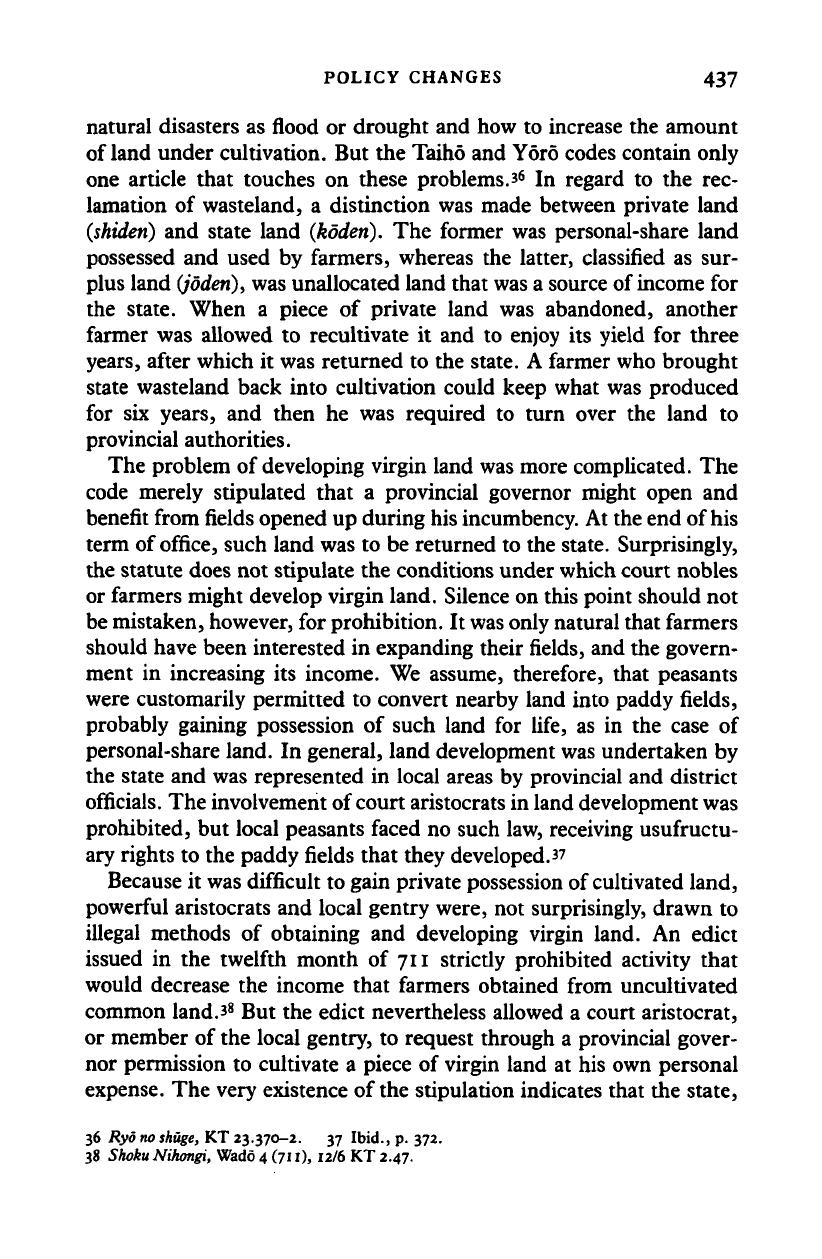
POLICY CHANGES 437
natural disasters as flood or drought and how to increase the amount
of land under cultivation. But the Taiho and Yoro codes contain only
one article that touches on these problems.*
6
In regard to the rec-
lamation of wasteland, a distinction was made between private land
(shiden)
and state land
(koden).
The former was personal-share land
possessed and used by farmers, whereas the latter, classified as sur-
plus land
(joden),
was unallocated land that was a source of income for
the state. When a piece of private land was abandoned, another
farmer was allowed to recultivate it and to enjoy its yield for three
years,
after which it was returned to the state. A farmer who brought
state wasteland back into cultivation could keep what was produced
for six years, and then he was required to turn over the land to
provincial authorities.
The problem of developing virgin land was more complicated. The
code merely stipulated that a provincial governor might open and
benefit from fields opened up during his incumbency. At the end of his
term of office, such land was to be returned to the state. Surprisingly,
the statute does not stipulate the conditions under which court nobles
or farmers might develop virgin land. Silence on this point should not
be mistaken, however, for prohibition. It
was
only natural that farmers
should have been interested in expanding their fields, and the govern-
ment in increasing its income. We assume, therefore, that peasants
were customarily permitted to convert nearby land into paddy fields,
probably gaining possession of such land for life, as in the case of
personal-share land. In general, land development was undertaken by
the state and was represented in local areas by provincial and district
officials. The involvement of court aristocrats in land development was
prohibited, but local peasants faced no such law, receiving usufructu-
ary rights to the paddy fields that they developed."
Because it was difficult to gain private possession of cultivated land,
powerful aristocrats and local gentry were, not surprisingly, drawn to
illegal methods of obtaining and developing virgin land. An edict
issued in the twelfth month of 711 strictly prohibited activity that
would decrease the income that farmers obtained from uncultivated
common land.*
8
But the edict nevertheless allowed a court aristocrat,
or member of the local gentry, to request through a provincial gover-
nor permission to cultivate a piece of virgin land at his own personal
expense. The very existence of the stipulation indicates that the state,
36 Ryo
no
shuge,
KT 23.370-2. 37 Ibid., p. 372.
38 ShokuNihongi, Wado 4 (711), 12/6 KT 2.47.
Cambridge Histories Online © Cambridge University Press, 2008
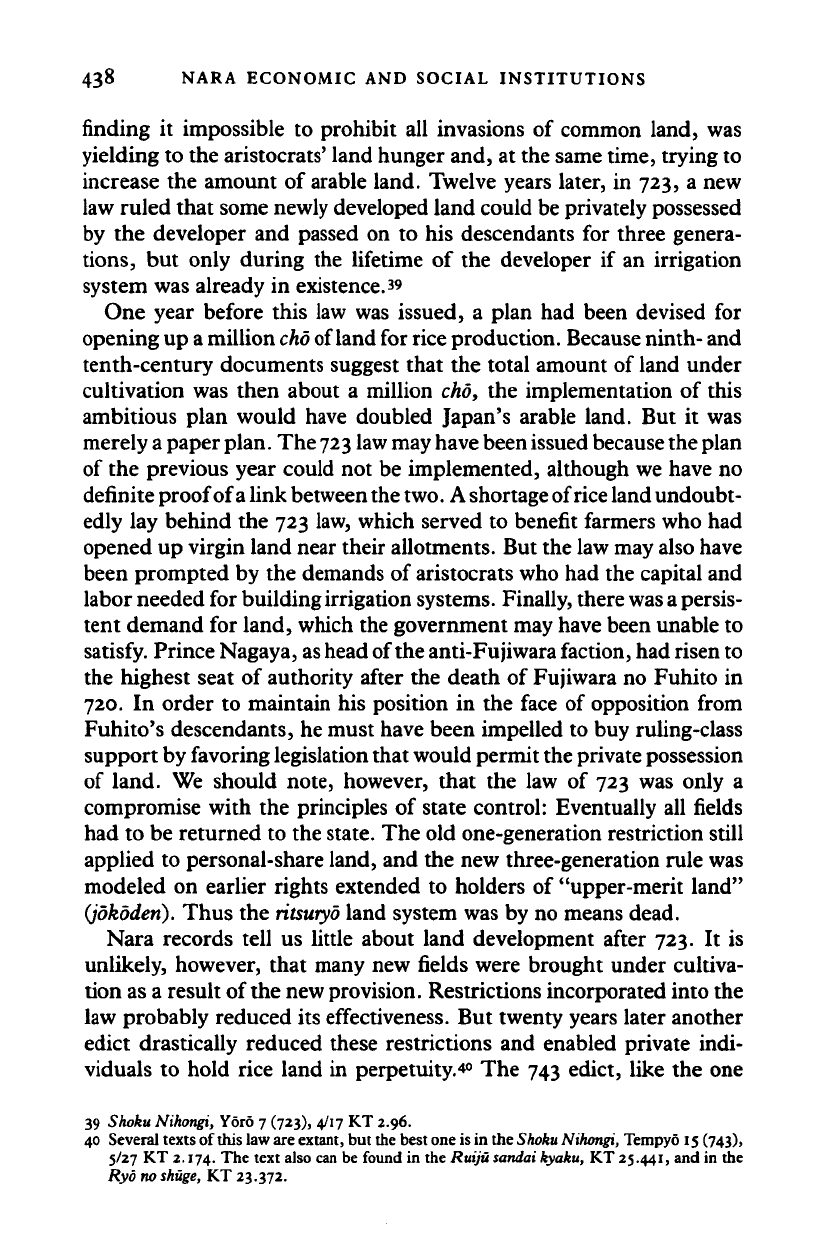
438 NARA ECONOMIC AND SOCIAL INSTITUTIONS
finding it impossible to prohibit all invasions of common land, was
yielding to the aristocrats' land hunger and, at the same time, trying to
increase the amount of arable land. Twelve years later, in 723, a new
law ruled that some newly developed land could be privately possessed
by the developer and passed on to his descendants for three genera-
tions,
but only during the lifetime of the developer if an irrigation
system was already in existence.
39
One year before this law was issued, a plan had been devised for
opening up
a
million
cho
of land for rice production. Because ninth- and
tenth-century documents suggest that the total amount of land under
cultivation was then about a million cho, the implementation of this
ambitious plan would have doubled Japan's arable land. But it was
merely
a
paper
plan.
The
723 law
may have been issued because the plan
of the previous year could not be implemented, although we have no
definite proof of
a
link between the
two.
A
shortage of rice land undoubt-
edly lay behind the 723 law, which served to benefit farmers who had
opened up virgin land near their allotments. But the law may also have
been prompted by the demands of aristocrats who had the capital and
labor needed for building irrigation systems. Finally, there
was a
persis-
tent demand for land, which the government may have been unable to
satisfy. Prince Nagaya,
as
head of the anti-Fujiwara faction, had risen to
the highest seat of authority after the death of Fujiwara no Fuhito in
720.
In order to maintain his position in the face of opposition from
Fuhito's descendants, he must have been impelled to buy ruling-class
support by favoring legislation that would permit the private possession
of land. We should note, however, that the law of 723 was only a
compromise with the principles of state control: Eventually all fields
had to be returned to the state. The old one-generation restriction still
applied to personal-share land, and the new three-generation rule was
modeled on earlier rights extended to holders of "upper-merit land"
(jokoden).
Thus the
ritsuryo
land system was by no means dead.
Nara records tell us little about land development after 723. It is
unlikely, however, that many new fields were brought under cultiva-
tion as a result of the new provision. Restrictions incorporated into the
law probably reduced its effectiveness. But twenty years later another
edict drastically reduced these restrictions and enabled private indi-
viduals to hold rice land in perpetuity.*> The 743 edict, like the one
39 Shoku Nihongi, Yoro 7 (723), 4/17 KT 2.96.
40 Several texts of this law are extant, but the best one is in the
Shoku
Nihongi, Tempyo 15 (743),
5/27 KT 2.174. The text also can be found in the Ruiju sandai kyaku, KT 25.441, and in the
Ryo no
shuge,
KT 23.372.
Cambridge Histories Online © Cambridge University Press, 2008
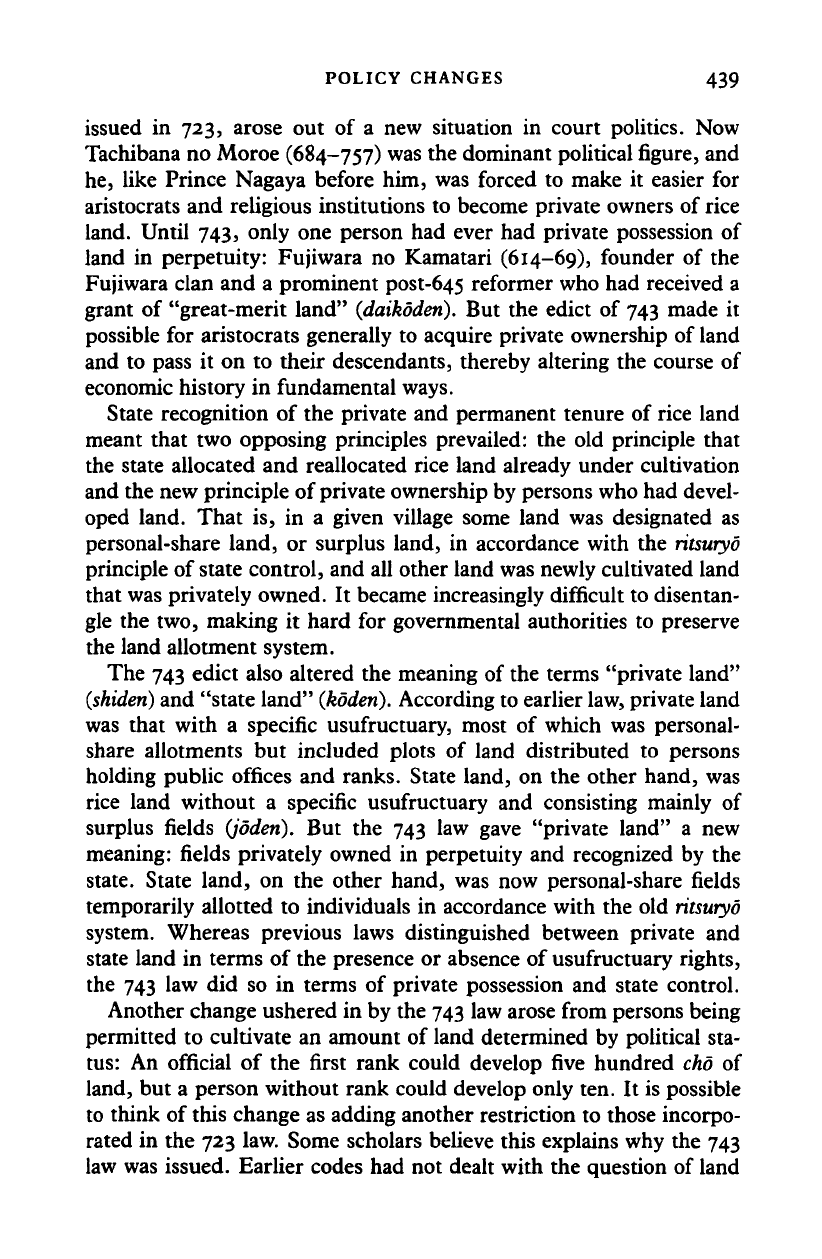
POLICY CHANGES 439
issued in 723, arose out of a new situation in court politics. Now
Tachibana no Moroe (684-757) was the dominant political figure, and
he,
like Prince Nagaya before him, was forced to make it easier for
aristocrats and religious institutions to become private owners of rice
land. Until 743, only one person had ever had private possession of
land in perpetuity: Fujiwara no Kamatari (614-69), founder of the
Fujiwara clan and a prominent post-645 reformer who had received a
grant of "great-merit land"
(daikoden).
But the edict of 743 made it
possible for aristocrats generally to acquire private ownership of land
and to pass it on to their descendants, thereby altering the course of
economic history in fundamental ways.
State recognition of the private and permanent tenure of rice land
meant that two opposing principles prevailed: the old principle that
the state allocated and reallocated rice land already under cultivation
and the new principle of private ownership by persons who had devel-
oped land. That is, in a given village some land was designated as
personal-share land, or surplus land, in accordance with the
ritsuryo
principle of state control, and all other land was newly cultivated land
that was privately owned. It became increasingly difficult to disentan-
gle the two, making it hard for governmental authorities to preserve
the land allotment system.
The 743 edict also altered the meaning of the terms "private land"
(shideri)
and "state land"
(koden).
According to earlier
law,
private land
was that with a specific usufructuary, most of which was personal-
share allotments but included plots of land distributed to persons
holding public offices and ranks. State land, on the other hand, was
rice land without a specific usufructuary and consisting mainly of
surplus fields
(jdderi).
But the 743 law gave "private land" a new
meaning: fields privately owned in perpetuity and recognized by the
state.
State land, on the other hand, was now personal-share fields
temporarily allotted to individuals in accordance with the old
ritsuryo
system. Whereas previous laws distinguished between private and
state land in terms of the presence or absence of usufructuary rights,
the 743 law did so in terms of private possession and state control.
Another change ushered in by the 743 law arose from persons being
permitted to cultivate an amount of land determined by political sta-
tus:
An official of the first rank could develop five hundred cho of
land, but a person without rank could develop only ten. It is possible
to think of this change as adding another restriction to those incorpo-
rated in the 723 law. Some scholars believe this explains why the 743
law was issued. Earlier codes had not dealt with the question of land
Cambridge Histories Online © Cambridge University Press, 2008

440 NARA ECONOMIC AND SOCIAL INSTITUTIONS
development, but if they had, limits on the amount of land that a
single individual could bring under cultivation would probably have
been deemed necessary. Therefore Yoshida Takashi concluded that
although the 743 law destroyed basic features of the
ritsuryo
land law, it
emerged from problems with the law's administration.
41
By making it
clear that the 743 regulation was an attempt to resolve such problems,
Yoshida made an important contribution. But the
743
restrictions were
loose and were probably not enforced. Restrictions on the amount of
land that temples could develop were not even spelled out, and after
743,
large amounts of
new
rice land appeared.
42
Some two decades later, in 765 when the court was dominated by
the Buddhist priest Dokyo (d. 772) and pro-Buddhist policies were
being adopted, land development by non-Buddhist institutions or aris-
tocratic individuals was prohibited.
4
^ Development by Buddhist tem-
ples was, on the other hand, implicitly approved. But when Dokyo fell
from power in 770, the provisions of the 743 law were apparently
restored.
44
Records show that during the remaining century and a
quarter of
ritsuryo
history, the amount of land brought under cultiva-
tion increased continuously and markedly.
In looking back over changes in land policy, we see two distinct
periods of land system disintegration. First is the period after 743
when individuals or religious institutions were permitted to possess
newly developed rice land personally and in perpetuity. This period
ended in 801 when the interval between allotments was lengthened
from six to twelve years.
4
? The second period lasted from about 800 to
the early tenth century when the
ritsuryo
land system virtually disap-
peared. A study of household registers and land allotment records
down to 800 provides results shown in Table 8.3. Two points should
be made about these figures. First, with only two exceptions, a census
was taken every six years. Second, the length of time between a census
and the following allotment was at first two years but by 800 was
lengthened to six.
Before 743, when reallotments were carried out regularly, they were
made two years after each census. But after the 743 edict, when the
41 Yoshida Takashi, Ritsuryo kokka
to
kodai
no
shakai, pp. 289-347.
42 Farris considers the great smallpox epidemic of 735-7 to have been the major factor in the
government's decision to eliminate restrictions on tenure; see Population, Disease and Land,
pp.
64-81.
43 Shoku Nihongi, Tempyo Jingo I (765) 3/5, 2.319.
44 Ruiju sandai kyaku, Council of State order, Hoki 3 (772) 10/14, KT, 25.441.
45 Ruiju sandai kyaku, Council of State, Enryaku 20 (801) 6/5, which is cited in an order issued
by the Council of State order, Jowa
1
(834) 2/3, KT 25.427.
Cambridge Histories Online © Cambridge University Press, 2008
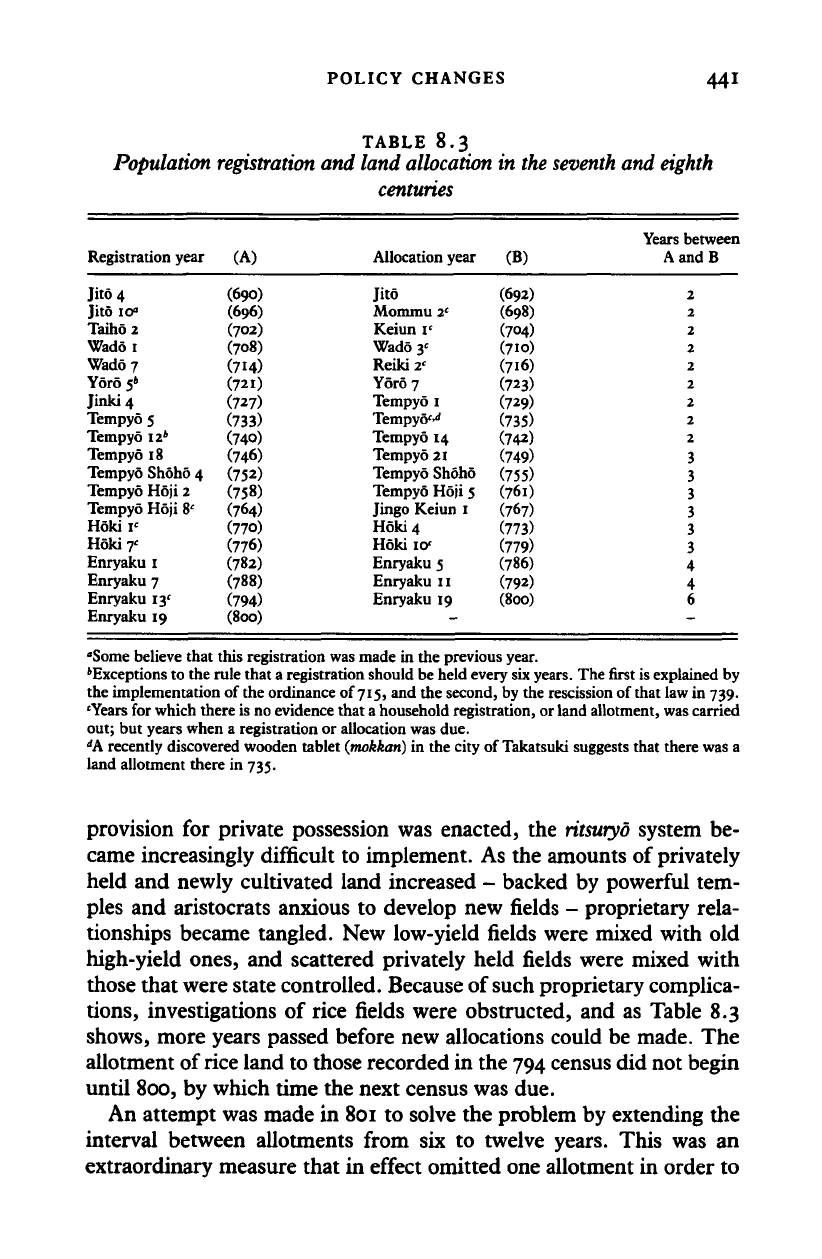
POLICY CHANGES 441
TABLE 8.3
Population
registration
and land
allocation
in the
seventh
and eighth
centuries
Registration year
Jito 4
Jito io°
Taih6 2
Wado 1
Wado 7
Yoro 5'
Jinki 4
Tempyo 5
Tempyo 12*
Tempyo 18
Tempyo Shoho 4
Tempyo Hoji 2
Tempyo Hoji 8'
Hokir
Hokir
Enryaku 1
Enryaku 7
Enryaku 13'
Enryaku 19
(A)
(690)
(696)
(702)
(708)
(714)
(72O
(727)
(733)
(74°)
(746)
(752)
(758)
(764)
(770)
(776)
(782)
(788)
(794)
(800)
Allocation year
Jito
Mommu 2'
Keiun l
e
Wado y
Reiki2'
Yoro 7
Tempyo 1
Tempy^
Tempyo 14
Tempyo 21
Tempyo Shoho
Tempyo Hoji 5
Jingo Keiun 1
H6ki
4
Hold io*
Enryaku 5
Enryaku 11
Enryaku 19
—
(B)
(692)
(698)
(704)
(710)
(716)
(723)
(729)
(735)
(742)
(749)
(755)
(761)
(767)
(773)
(779)
(786)
(792)
(800)
Years between
AandB
2
2
2
2
2
2
2
2
2
3
3
3
3
3
3
4
4
6
-
"Some believe that this registration was made in the previous year.
'Exceptions to the rule that
a
registration should be held every six
years.
The
first
is explained by
the implementation of the ordinance of
715,
and the second, by the rescission of that law in 739.
'Years for which there
is
no evidence that a household registration, or land allotment, was carried
out; but years when a registration or allocation was due.
d
A recently discovered wooden tablet
(mokkan)
in the city of Takatsuki suggests that there was a
land allotment there in 735.
provision for private possession was enacted, the
ritsuryd
system be-
came increasingly difficult to implement. As the amounts of privately
held and newly cultivated land increased - backed by powerful tem-
ples and aristocrats anxious to develop new fields - proprietary rela-
tionships became tangled. New low-yield fields were mixed with old
high-yield ones, and scattered privately held fields were mixed with
those that were state controlled. Because of such proprietary complica-
tions,
investigations of rice fields were obstructed, and as Table 8.3
shows, more years passed before new allocations could be made. The
allotment of rice land to those recorded in the 794 census did not begin
until 800, by which time the next census was due.
An attempt was made in
801
to solve the problem by extending the
interval between allotments from six to twelve years. This was an
extraordinary measure that in effect omitted one allotment in order to
Cambridge Histories Online © Cambridge University Press, 2008
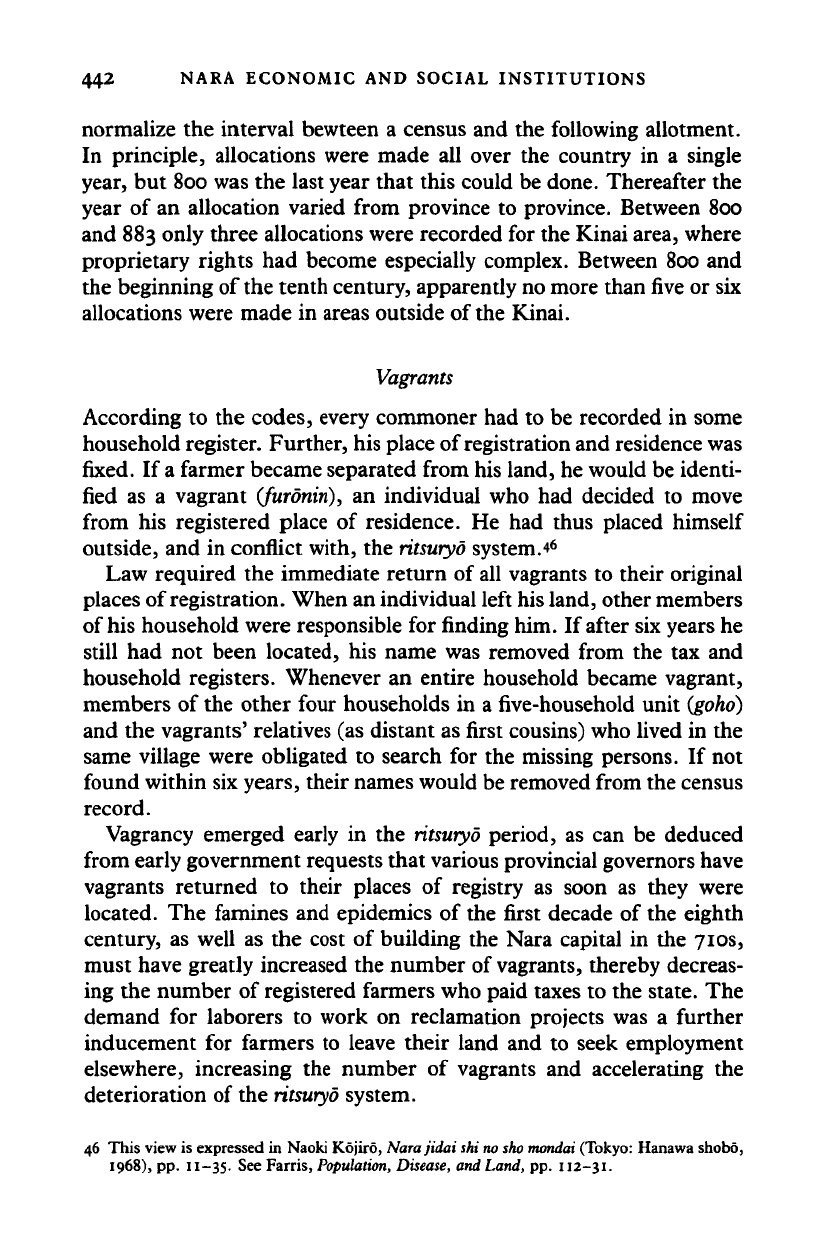
442 NARA ECONOMIC AND SOCIAL INSTITUTIONS
normalize the interval bewteen a census and the following allotment.
In principle, allocations were made all over the country in a single
year, but 800 was the last year that this could be done. Thereafter the
year of an allocation varied from province to province. Between 800
and 883 only three allocations were recorded for the Kinai area, where
proprietary rights had become especially complex. Between 800 and
the beginning of the tenth century, apparently no more than five or six
allocations were made in areas outside of the Kinai.
Vagrants
According to the codes, every commoner had to be recorded in some
household register. Further, his place of registration and residence was
fixed. If
a
farmer became separated from his land, he would be identi-
fied as a vagrant
(furonin),
an individual who had decided to move
from his registered place of residence. He had thus placed himself
outside, and in conflict with, the
ritsuryd
system.-"
Law required the immediate return of all vagrants to their original
places of registration. When an individual left his land, other members
of
his
household were responsible for finding him. If after six years he
still had not been located, his name was removed from the tax and
household registers. Whenever an entire household became vagrant,
members of the other four households in a
five-household
unit
(goho)
and the vagrants' relatives (as distant as first cousins) who lived in the
same village were obligated to search for the missing persons. If not
found within six years, their names would be removed from the census
record.
Vagrancy emerged early in the
ritsuryd
period, as can be deduced
from early government requests that various provincial governors have
vagrants returned to their places of registry as soon as they were
located. The famines and epidemics of the first decade of the eighth
century, as well as the cost of building the Nara capital in the 710s,
must have greatly increased the number of
vagrants,
thereby decreas-
ing the number of registered farmers who paid taxes to the state. The
demand for laborers to work on reclamation projects was a further
inducement for farmers to leave their land and to seek employment
elsewhere, increasing the number of vagrants and accelerating the
deterioration of the
ritsuryd
system.
46 This view is expressed in Naoki Kojiro, Narajidai shi
no
sho
mondai
(Tokyo: Hanawa shobo,
1968),
pp. 11-35. See Farris,
Population,
Disease, and Land, pp. 112-31.
Cambridge Histories Online © Cambridge University Press, 2008
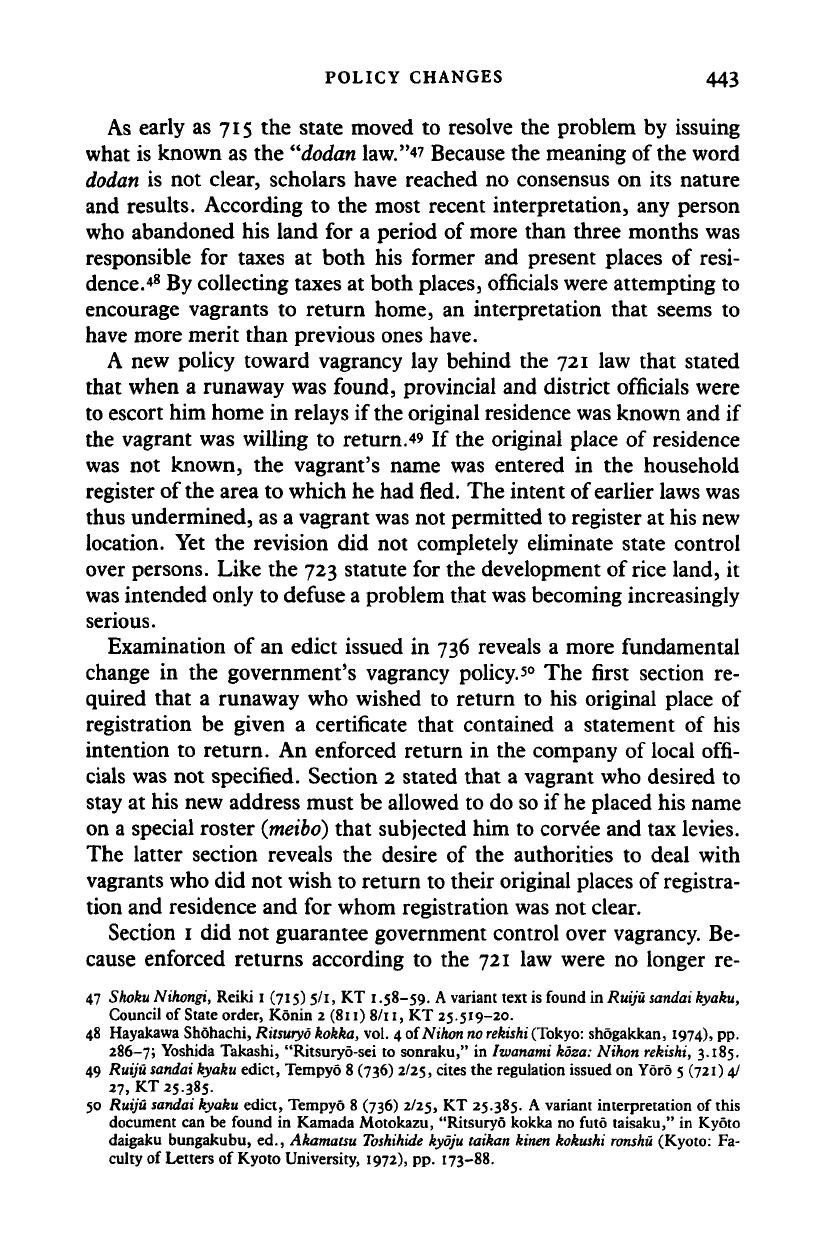
POLICY CHANGES 443
As early as 715 the state moved to resolve the problem by issuing
what is known as the
"dodan
law."
47
Because the meaning of the word
dodan
is not clear, scholars have reached no consensus on its nature
and results. According to the most recent interpretation, any person
who abandoned his land for a period of more than three months was
responsible for taxes at both his former and present places of resi-
dence.
48
By collecting taxes at both places, officials were attempting to
encourage vagrants to return home, an interpretation that seems to
have more merit than previous ones have.
A new policy toward vagrancy lay behind the 721 law that stated
that when a runaway was found, provincial and district officials were
to escort him home in relays if the original residence was known and if
the vagrant was willing to return.
49
If the original place of residence
was not known, the vagrant's name was entered in the household
register of the area to which he had fled. The intent of earlier laws was
thus undermined, as a vagrant was not permitted to register at his new
location. Yet the revision did not completely eliminate state control
over persons. Like the 723 statute for the development of rice land, it
was intended only to defuse a problem that was becoming increasingly
serious.
Examination of an edict issued in 736 reveals a more fundamental
change in the government's vagrancy policy. 5° The first section re-
quired that a runaway who wished to return to his original place of
registration be given a certificate that contained a statement of his
intention to return. An enforced return in the company of local offi-
cials was not specified. Section 2 stated that a vagrant who desired to
stay at his new address must be allowed to do so if
he
placed his name
on a special roster
(meibo)
that subjected him to corvee and tax levies.
The latter section reveals the desire of the authorities to deal with
vagrants who did not wish to return to their original places of registra-
tion and residence and for whom registration was not clear.
Section 1 did not guarantee government control over vagrancy. Be-
cause enforced returns according to the 721 law were no longer re-
47
Shoku
Nihongi, Reiki I (715) 5/1, KT 1.58-59. A variant text is found in Ruiju sandai kyaku,
Council of State order, Konin 2(811)8/11, KT 25.519-20.
48 Hayakawa Shohachi, Ritsuryo kokka, vol. 4 of Nihon
no rekishi
(Tokyo:
shogakkan, 1974), pp.
286-7; Yoshida Takashi, "Ritsuryo-sei to sonraku," in Iwanami koza: Nihon rekishi, 3.185.
49 Ruiju sandai kyaku edict, Tempyo 8 (736) 2/25, cites the regulation issued on Yoro 5 (721) 4/
27,
KT 25.385.
50 Ruiju sandai kyaku edict, Tempyo 8 (736) 2/25, KT 25.385. A variant interpretation of this
document can be found in Kamada Motokazu, "Ritsuryo kokka no futo taisaku," in Kyoto
daigaku bungakubu, ed., Akamatsu
Toshihide
kyoju taikan kinen kokuski
ronshu
(Kyoto: Fa-
culty of Letters of Kyoto University, 1972), pp. 173-88.
Cambridge Histories Online © Cambridge University Press, 2008
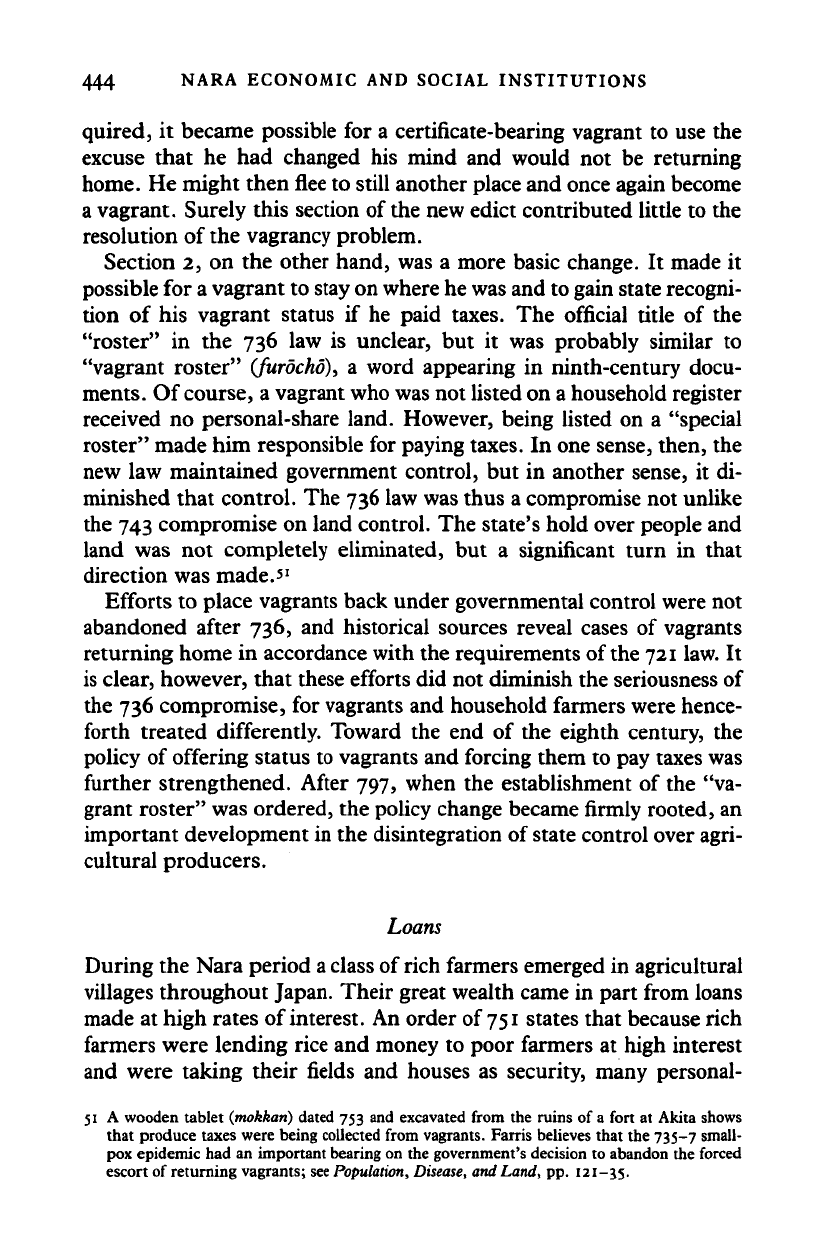
444 NARA ECONOMIC AND SOCIAL INSTITUTIONS
quired, it became possible for a certificate-bearing vagrant to use the
excuse that he had changed his mind and would not be returning
home. He might then flee to still another place and once again become
a vagrant. Surely this section of the new edict contributed little to the
resolution of the vagrancy problem.
Section 2, on the other hand, was a more basic change. It made it
possible for a vagrant to stay on where he was and to gain state recogni-
tion of his vagrant status if he paid taxes. The official title of the
"roster" in the 736 law is unclear, but it was probably similar to
"vagrant roster"
(furocho),
a word appearing in ninth-century docu-
ments. Of
course,
a vagrant who was not listed on a household register
received no personal-share land. However, being listed on a "special
roster" made him responsible for paying taxes. In one sense, then, the
new law maintained government control, but in another sense, it di-
minished that control. The 736 law was thus a compromise not unlike
the 743 compromise on land control. The state's hold over people and
land was not completely eliminated, but a significant turn in that
direction was made.'
1
Efforts to place vagrants back under governmental control were not
abandoned after 736, and historical sources reveal cases of vagrants
returning home in accordance with the requirements of
the 721
law. It
is clear, however, that these efforts did not diminish the seriousness of
the 736 compromise, for vagrants and household farmers were hence-
forth treated differently. Toward the end of the eighth century, the
policy of offering status to vagrants and forcing them to pay taxes was
further strengthened. After 797, when the establishment of the "va-
grant roster" was ordered, the policy change became firmly rooted, an
important development in the disintegration of state control over agri-
cultural producers.
Loans
During the Nara period
a
class of rich farmers emerged in agricultural
villages throughout Japan. Their great wealth came in part from loans
made at high rates of interest. An order of
751
states that because rich
farmers were lending rice and money to poor farmers at high interest
and were taking their fields and houses as security, many personal-
51 A wooden tablet (mokkan) dated 753 and excavated from the ruins of a fort at Akita shows
that produce taxes were being collected from vagrants. Farris believes that the 735-7 small-
pox epidemic had an important bearing on the government's decision to abandon the forced
escort of returning vagrants; see Population, Disease, and
Land,
pp. 121-35.
Cambridge Histories Online © Cambridge University Press, 2008
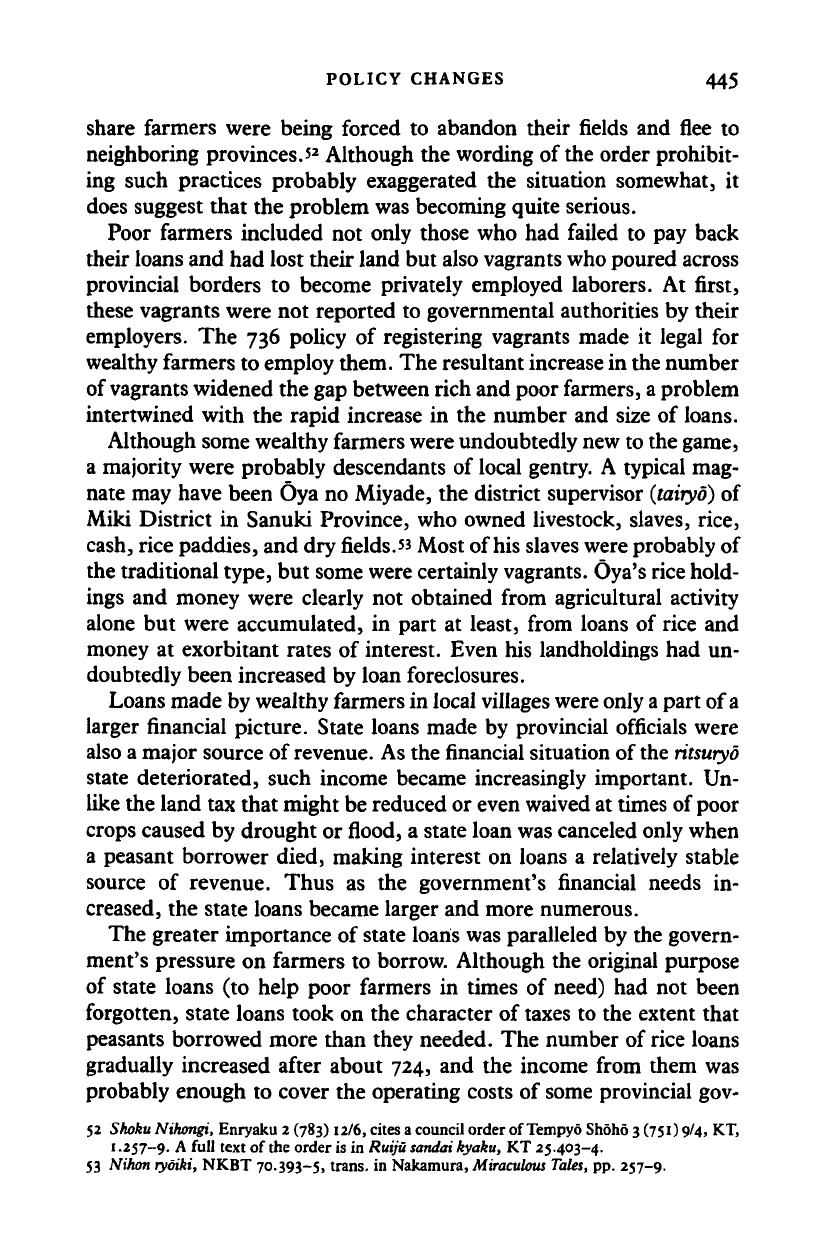
POLICY CHANGES 445
share farmers were being forced to abandon their fields and flee to
neighboring provinces.'
2
Although the wording of the order prohibit-
ing such practices probably exaggerated the situation somewhat, it
does suggest that the problem was becoming quite serious.
Poor farmers included not only those who had failed to pay back
their loans and had lost their land but also vagrants who poured across
provincial borders to become privately employed laborers. At first,
these vagrants were not reported to governmental authorities by their
employers. The 736 policy of registering vagrants made it legal for
wealthy fanners to employ them. The resultant increase in the number
of vagrants widened the gap between rich and poor farmers,
a
problem
intertwined with the rapid increase in the number and size of loans.
Although some wealthy fanners were undoubtedly new to the game,
a majority were probably descendants of local gentry. A typical mag-
nate may have been Oya no Miyade, the district supervisor
{tairyo)
of
Miki District in Sanuki Province, who owned livestock, slaves, rice,
cash, rice paddies, and dry fields.^ Most of his slaves were probably of
the traditional type, but some were certainly vagrants. Oya's rice hold-
ings and money were clearly not obtained from agricultural activity
alone but were accumulated, in part at least, from loans of rice and
money at exorbitant rates of interest. Even his landholdings had un-
doubtedly been increased by loan foreclosures.
Loans made by wealthy farmers in local villages were only
a
part of a
larger financial picture. State loans made by provincial officials were
also a major source of
revenue.
As the
financial
situation of the
ritsuryo
state deteriorated, such income became increasingly important. Un-
like the land tax that might be reduced or even waived at times of poor
crops caused by drought or flood, a state loan was canceled only when
a peasant borrower died, making interest on loans a relatively stable
source of revenue. Thus as the government's financial needs in-
creased, the state loans became larger and more numerous.
The greater importance of state loans was paralleled by the govern-
ment's pressure on farmers to borrow. Although the original purpose
of state loans (to help poor farmers in times of need) had not been
forgotten, state loans took on the character of taxes to the extent that
peasants borrowed more than they needed. The number of rice loans
gradually increased after about 724, and the income from them was
probably enough to cover the operating costs of some provincial gov-
52 Shoku Nihongi, Enryaku 2 (783) 12/6, cites a council order of Tempyo Shoho 3 (751) 9/4, KT,
1.257-9. A ful] text of the order is in Ruiju sandai kyaku, KT 25.403-4.
53 Nihon ryoiki, NKBT 70.393-5, trans, in Nakamura,
Miraculous
Tales, pp. 257-9.
Cambridge Histories Online © Cambridge University Press, 2008
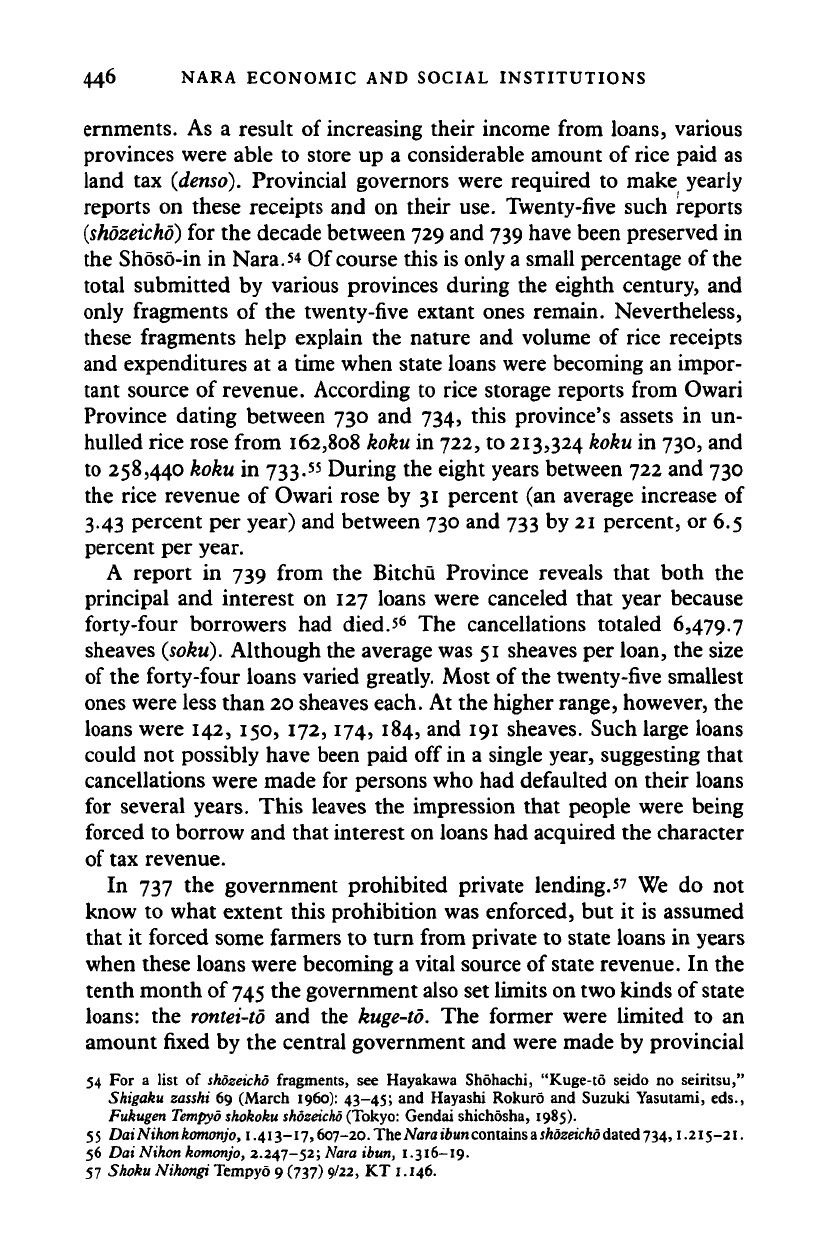
446 NARA ECONOMIC AND SOCIAL INSTITUTIONS
ernments. As a result of increasing their income from loans, various
provinces were able to store up a considerable amount of rice paid as
land tax
(denso).
Provincial governors were required to make yearly
reports on these receipts and on their use. Twenty-five such reports
(shozeicho)
for the decade between 729 and 739 have been preserved in
the Shoso-in in Nara.s* Of course this is only a small percentage of the
total submitted by various provinces during the eighth century, and
only fragments of the twenty-five extant ones remain. Nevertheless,
these fragments help explain the nature and volume of rice receipts
and expenditures at a time when state loans were becoming an impor-
tant source of revenue. According to rice storage reports from Owari
Province dating between 730 and 734, this province's assets in un-
hulled rice rose from 162,808 koku in 722, to 213,324
koku
in 730, and
to 258,440 koku in 733.ss During the eight years between 722 and 730
the rice revenue of Owari rose by 31 percent (an average increase of
3.43 percent per year) and between 730 and 733 by
21
percent, or 6.5
percent per year.
A report in 739 from the Bitchu Province reveals that both the
principal and interest on 127 loans were canceled that year because
forty-four borrowers had died.5
6
The cancellations totaled 6,479.7
sheaves
(soku).
Although the average was
51
sheaves per loan, the size
of the forty-four loans varied greatly. Most of the twenty-five smallest
ones were less than 20 sheaves each. At the higher range, however, the
loans were 142, 150, 172,174, 184, and 191 sheaves. Such large loans
could not possibly have been paid off in a single year, suggesting that
cancellations were made for persons who had defaulted on their loans
for several years. This leaves the impression that people were being
forced to borrow and that interest on loans had acquired the character
of tax revenue.
In 737 the government prohibited private lending.5? We do not
know to what extent this prohibition was enforced, but it is assumed
that it forced some farmers to turn from private to state loans in years
when these loans were becoming a vital source of state revenue. In the
tenth month of
745
the government also set limits on two kinds of state
loans:
the
rontei-to
and the
kuge-to.
The former were limited to an
amount fixed by the central government and were made by provincial
54 For a list of shozeicho fragments, see Hayakawa Shohachi, "Kuge-to seido no seiritsu,"
Shigaku zasshi 69 (March i960): 43-45; and Hayashi Rokuro and Suzuki Yasutami, eds.,
Fukugen
Tempyo shokoku shozeicho
(Tokyo: Gendai shichosha, 1985).
55 DaiNihonkomonjo, 1.413-17,607-20. TheMjraiiun contains
a sAdzeicAd
dated 734,1.215-21.
56 DaiNihonkomonjo, 2.247-52; Nara ibun, 1.316-19.
57 Shoku Nihongi Tempyo 9 (737) 9/22, KT 1.146.
Cambridge Histories Online © Cambridge University Press, 2008
